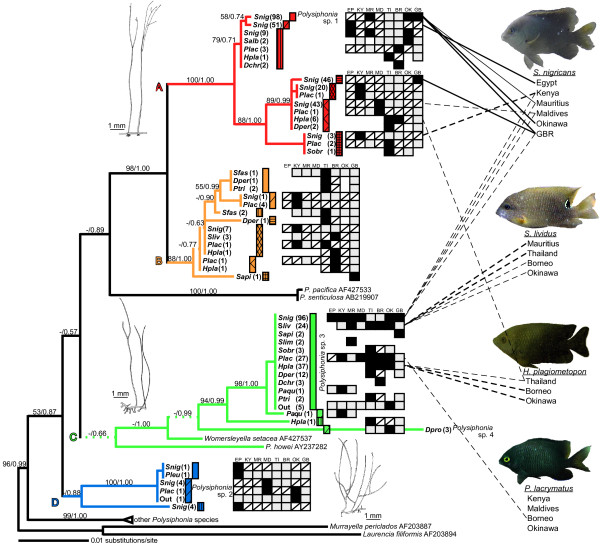Figure 1.
Phylogeny of Polysiphonia algae found inside and outside the territories of 15 damselfish species. Each alga is denoted by the abbreviation of its damselfish host species that is shown in Table 1. 'Out' indicates algae collected outside damselfish territories. Numbers in parentheses indicate the number of DNA samples including partially sequenced samples. Data presented as the scientific names of algae with accession numbers denote citations from the NCBI GenBank. Black blocks indicate the locations from which the algae were collected (EP, Egypt; KY, Kenya; MR, Mauritius; MD, the Maldives; TI, Thailand; BR, Borneo; OK, Okinawa; GB, the GBR). Gray blocks indicate areas inhabited by damselfish for which we have no data; blocks with slashes denote sites inhabited by damselfish where the alga was not found; open blocks indicate areas uninhabited by the fish. The tree was obtained using the ML method based on 1531 bp of 18S rDNA. Branches that collapse in MP, ML, and/or BI trees are presented as broken lines. Nodal support was assessed by the bootstrap value of MP and posterior probabilities of BI (above branches, MP/BI, respectively). Four abundant and widely-distributed damselfish species are listed on the right column, and their localities were linked with inhabitant Polysiphonia algae. Broad and narrow links indicate that the alga occurred in ≥ 50% or ≥ 25% of the territories of the damselfish species at these sites, respectively. Solid and broken lines indicate that the algal species occurred only within the territories of the fish species or that they also occurred in territories of other fish species and/or outside the damselfish territories, respectively.

